
Saint Patrick's Church is a Catholic parish in the Archdiocese of Dubuque, and is located at 15th and Iowa Streets, Dubuque, Iowa, United States. The church and rectory were included as contributing properties in the Jackson Park Historic District that was listed on the National Register of Historic Places in 1986. St. Patrick's Church is located two blocks away from St. Mary's Church. The reason for the close proximity of the two parishes was that St. Mary was originally built for service to German families of Dubuque, and St. Patrick's provided services for the Irish settlers to Dubuque.

St. Ambrose Cathedral is a historic building located in downtown Des Moines, Iowa, United States. It serves as a parish church and as the seat of the Diocese of Des Moines in the Catholic Church. The cathedral, along with the adjoining rectory, was listed on the National Register of Historic Places in 1979.
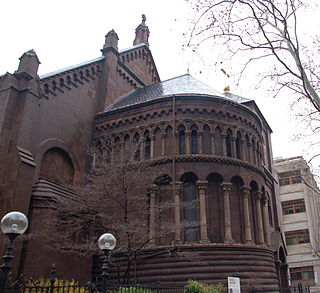
Saint Clement's Church is an historic Anglo-Catholic parish in Logan Square, Center City, Philadelphia. It is part of the Episcopal Diocese of Pennsylvania. The church, designed by architect John Notman, was built in 1856. It originally incorporated a spire more than 200 feet (61 m) tall; this was found to be too heavy for the foundation and was removed in 1869. In 1929, the church building, which includes the parish house and rectory, and weighs 5,000 short tons (4,500 t), was lifted onto steel rollers and moved 40 feet (12 m) west to allow for the widening of 20th Street. On November 20, 1970, Saint Clement's Church was listed on the National Register of Historic Places.
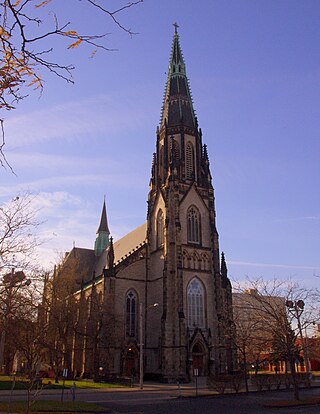
St. Joseph Shrine, founded in 1855, is a historic German Catholic church located at 1828 Jay Street in the Eastern Market–Lafayette Park neighborhood area just outside downtown Detroit, Michigan, on the city's central east side. The building was listed on the National Register of Historic Places in 1972, and deemed "of national importance" because of its stained glass. Three subsidiary buildings—the rectory, convent, and the Wermers House—were added to the listing in 1992. It is under the jurisdiction of the Archdiocese of Detroit, and presently a shrine dedicated to the celebration of the pre-Vatican II liturgy under the care of the canons of the Institute of Christ the King Sovereign Priest.

St. John the Evangelist is a historic Roman Catholic Church at 2270 Massachusetts Avenue in Cambridge, Massachusetts.

Saint Aidan's Church and Rectory is a historic Catholic church complex in Brookline, Massachusetts. The stuccoed church, located at 224-210 Freeman Street, was designed by Maginnis & Walsh, a noted designer of ecclesiastical buildings, in the Medieval (Tudor) Revival style, and was built in 1911. It was Brookline's third Catholic parish, after Saint Mary's and Saint Lawrence. The church is notable as the parish which was attended by Joseph P. Kennedy and his family when they were living on Beals Street; it was the site of the baptism of both John F. Kennedy and Robert F. Kennedy. The rectory, located at 158 Pleasant Street, was built c. 1850-55 by Edward G. Parker, a Boston lawyer. It was acquired by the church in 1911, and restyled to match the church in 1920.

The National Shrine of St. Alphonsus Liguori, also known as St. John Neumann Shrine and "Baltimore's Powerhouse of Prayer," is part of a historic Catholic church complex in Baltimore, Maryland. Founded by the Redemptorists in 1917, the church has extensive affiliations with important figures in Baltimore Catholic history. Since 1992, the parish has held regular Tridentine Masses. It is currently administered by the Priestly Fraternity of Saint Peter. The complex was added to the National Register of Historic Places in 1973 as St. Alphonsus Church, Rectory, Convent and Halle.

St. Mary's Catholic Church, also known as St. Mary of the Visitation Church, is a parish church of the Diocese of Davenport which is located in Iowa City, Iowa, United States. The church building and rectory were listed together on the National Register of Historic Places in 1980. They were both included as contributing properties in the Jefferson Street Historic District in 2004. The parish's first rectory, which is now a private home, is also listed on the National Register as St. Mary's Rectory. It is located a few blocks to the east of the present church location at 610 E. Jefferson St.

Tippecanoe Place is a house on West Washington Street in South Bend, Indiana, United States. Built in 1889, it was the residence of Clement Studebaker, a co-founder of the Studebaker vehicle manufacturing firm. Studebaker lived in the house from 1889 until his 1901 death. The house is one of the few surviving reminders of the Studebaker automotive empire, which was the only major coach manufacturing business to successfully transition to the manufacture of automobiles. In 1973, the Richardsonian Romanesque mansion was listed on the National Register of Historic Places. It was further recognized by being designated a National Historic Landmark in 1977. It is located in South Bend's West Washington Historic District.

Grace Episcopal Church Complex is a historic Episcopal church complex located at Lyons in Wayne County, New York. The complex consists of a contributing stone church building begun in 1838, a contributing frame rectory begun about 1833, and a contributing parish house built in 1887–1888. The church building is Gothic Revival in style and constructed of rubble limestone walls with cut limestone trim. The rectory is an irregularly massed two story, wood-frame building incorporating a former private residence built at this site about 1833 in the vernacular late Federal / early Greek Revival style. The parish house is a single story, frame building designed in the Queen Anne style.

Saint Peter the Apostle Church is a historic Roman Catholic church at 94 Somerset Street in New Brunswick, Middlesex County, New Jersey, United States.
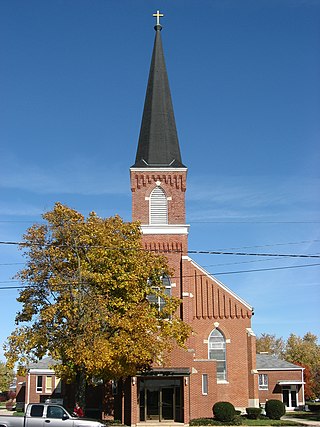
St. Nicholas Catholic Church is a historic Roman Catholic church in Osgood, Ohio, United States. Built in the first years of the 20th century, it houses one of the newest parishes in a heavily Catholic region of far western Ohio, but it has been recognized as a historic site for its architecture.
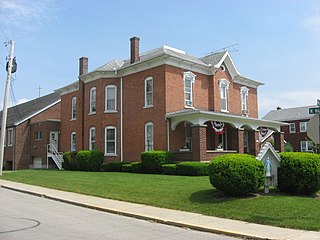
Immaculate Conception Catholic Church is a Roman Catholic parish in Botkins, Ohio, United States. Erected in 1865, the parish owns a complex of buildings constructed in a wide range of years, including two that have been designated as historic sites.

Precious Blood Catholic Church is a Roman Catholic parish in Chickasaw, Ohio, United States. Erected in 1903 and still an active parish, the church historically owned two buildings constructed in its early years that have been designated as historic sites.

The Nativity of the Blessed Virgin Mary Catholic Church is a Catholic church in Cassella, an unincorporated community in Mercer County, Ohio, United States. One of several Catholic churches in Marion Township, it was designated a historic site because of its well-preserved 19th-century architecture.
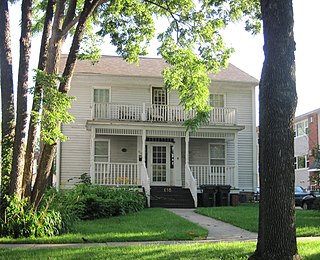
The former St. Mary's Rectory is a historic building located in Iowa City, Iowa, United States. Now a private home, the residence housed the Catholic clergy that served St. Mary's Catholic Church from 1854 to 1892. At that time the house was located next to the church, which is four blocks to the west. It was listed on the National Register of Historic Places in 1995.
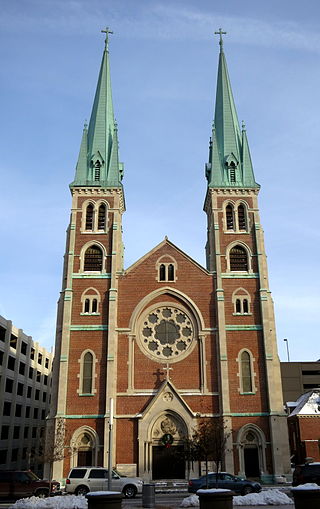
Saint John the Evangelist Catholic Church is a Catholic parish of the Archdiocese of Indianapolis in Indianapolis, Indiana, United States. The parish's origins date to 1837, when it was first named Holy Cross parish. In 1850 it was renamed Saint John the Evangelist parish, and is the oldest Catholic parish in the city and in Marion County, Indiana. Considered the mother of the Catholic parishes in Indianapolis, it played an important role in development of the Catholic Church in the city. Saint John's Church served as the pro-cathedral of the diocese from 1878 until 1906; its rectory served as the bishop's residence and chancery from 1878 until 1892. In 1900 the church served as the site of first episcopal consecration held in Indianapolis.

The St. Joseph's Church Complex is a collection of historic buildings located in Fort Madison, Iowa, United States. At one time the complex housed a Catholic parish in the Diocese of Davenport. St. Joseph and St. Mary of the Assumption parishes merged in the 1990s to form Saints Mary and Joseph Parish. In 2007 when that parish merged with Sacred Heart on the west side to form Holy Family Parish, St. Joseph's Church was closed. The former church, chapel, rectory, convent, and school were included as contributing properties in the Park-to-Park Residential Historic District that was listed on the National Register of Historic Places in 2014.

The John B. Hanten House, located at 518 E. Kemp Ave. in Watertown, South Dakota, was built in 1913. It was listed on the National Register of Historic Places in 1990.

Sacred Heart Church-Punahou is located at 1701 Wilder Avenue, in Honolulu, in the U.S. state of Hawaii. The church was dedicated in 1914, and its adjacent Bachelot Hall was dedicated in 1923. The property's rectory was built in 1927. It was added to the National Register of Historic Places listings on February 6, 2001.























